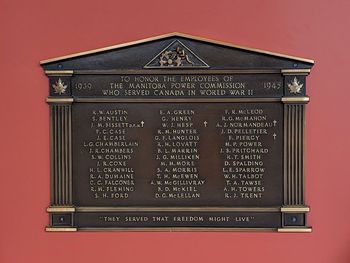
The bronze plaque honouring Manitoba Power Commission employees who served and who were killed in WWII at Manitoba Hydro Place.
A Manitoba Power Commission bronze plaque created in 1949, as a tribute to its employees who served and who were killed in World War II, has been re-installed in the main floor public gallery of Manitoba Hydro Place for Remembrance Day 2022.
The plaque was first installed at the Manitoba Power Commission’s head office on Donald Avenue – the Manitoba Power Commission (MPC) was the predecessor of Manitoba Hydro and was responsible for supplying electricity to rural Manitoba. The plaque later hung at Manitoba Hydro’s former head office at 820 Taylor Ave. and was moved to Manitoba Hydro Place in 2018 when employees were relocated to the downtown head office. It was in storage until now.
It’s installed on wall around the corner of the water feature closest to Portage Avenue. It’s also featured on the Canadian Military Memorials Database administered by Veterans Affairs Canada.
About the plaque – 1949
From the Sept.-Oct. 1949 MPC employee newsletter The Bulletin:
THE HONOUR ROLL
As a permanent tribute to members of the Manitoba Power Commission staff who served in World War II, a bronze plaque has been erected to replace a temporary honour roll which has been hanging in our head office at Winnipeg since the war.
On the plaque pictured above are four names of men who lost their lives in the fight for freedom: J. M. Bissett, D.F.M., W. J. Hesp, A. J. Normandeau and F. Piercy.
The plaque was designed by Mr. Percy R. Marsh of Winnipeg.
The Honour Roll Committee consisted of: Bob Coxe, Accounting Department; Doug Wade, Supply Department; Parry Power, Personnel Officer.
We will remember them
Jack Montgomery Bissett
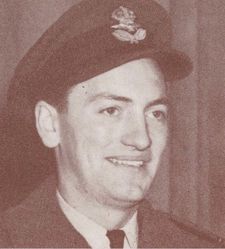
Flight Sergeant Jack Montgomery Bissett, RCAF.
He was killed March 31, 1944 when the Halifax bomber he was flying was shot down by a German night fighter on return from a bombing run on the German city of Nuremberg. Flight records say the plane exploded in mid-air and crashed at Herhahn, Germany.
Bissett, a squadron leader in the Royal Canadian Air Force, earned the Distinguished Flying Medal at Buckingham Palace on May 7, 1943 after flying 26 sorties. The citation reads: “Flight Sergeant Bissett has displayed great courage and determination to accomplish his tasks successfully. He has taken part in many sorties including attacks on various targets in the well defended Ruhr area. A fearless captain, his fine example has proved inspiring.”
Born in Pilot Mound, Bissett joined the MPC in June 1940 and enlisted in the Royal Canadian Air Force the following April.
From the October 1944 MPC Bulletin (on his death):
“His hydro friends watched his brilliant air force career with considerable pride. In the spring of this year he was decorated by the King at Buckingham Palace. Jack was killed on his second tour of operations.
It is useless to try and put into words the sorrow wrought by the death of such a fine young man. But perhaps it is some consolation to know that Jack in the past few years lived a life of the richest of experiences - a fuller life than we, who are grounded at home, will ever know.”
Bissett is buried at the Rheinberg War Cemetery in Germany. There are 3,326 Commonwealth servicemen of the Second World War buried or commemorated at Rheinberg War Cemetery. The majority were air crews.
William John Hesp
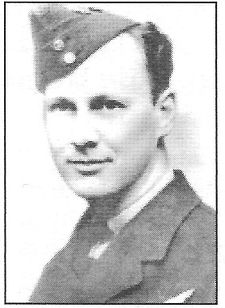
Navigator William John Hesp, RCAF.
He was killed Aug. 29, 1942 returning from a night bombing run on rail yards at Saarbrücken, Germany near the French border. He served as a navigator on a Wellington bomber in the Royal Air Force. The plane crashed on the south bank of the Aisne at Attigny, France. His grave is at the Attigny Communal Cemetery. He was 27.
He was an office clerk for the MPC purchasing department from 1939 until enlisting on Jan. 7, 1941.
From the September 1942 MPC Bulletin (a letter from Hesp to MPC staff):
“I didn’t come so far from being crewed up with Jack Bissett after all. He came to this station just a few days ago. If I had come in about two or three weeks later we could have made it.
That’s fate for you - eh? He got stuck on some advanced flying station for about three months or so.
“I was crewed up with a Canadian pilot - all Canadian crew as a matter of fact – but it seems they didn’t like the way he handled the kite and washed him out today. I believe I am now going to get an Englishman for a pilot – some chap who has been on Ops. for a while and lost his crew when somebody took them on a raid while he was away. He has come here to get another.
I haven’t met him as yet but should get the low down on things tomorrow.
“It must be pleasant for the men – to be at work with all you beautiful women back in the office.”
From the February 1943 MPC Bulletin (on his death):
“Definite word has now been received, confirming the death of Bill Hesp. He has been buried in a small town in France – and thus ends another eternity of waiting for family and friends. Those of the MPC staff who knew Bill will not soon forget him. His happy-go-lucky way will be missed when the old staff begins to remuster, after the war.”
Alphonse Jean Paul Normandeau
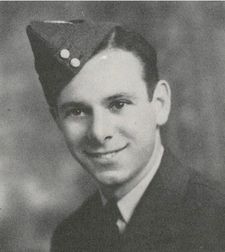
Warrant Officer 1st Class Alphonse Jean Paul Normandeau, RCAF.
He was killed March 16, 1944 in a training accident in England. An air gunner in a Halifax bomber, Normandeau’s plane was practicing low-level bombing runs in day light when it flew out of clouds and into the ground near York. All crew were killed. Normandeau was 24. He is buried at Harrogate (Stonefall) Cemetery. Most graves are for air crews, two-thirds belonging to the Canadian forces.
Before enlisting for the RCAF on June 20, 1941, he was a clerk for the Manitoba Power Commission at its Winnipeg head office.
Reginald Frank Piercy
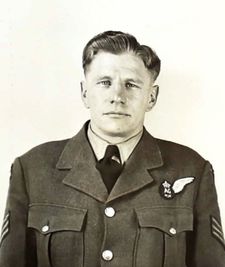
Flight Sergeant Reginald Frank Piercy, RCAF.
An air gunner in a Halifax, he was killed February 25, 1945 while his flight was on a night minelaying operation in Oslo Fjord, Norway. The entire crew were killed and lost without a trace. Piercy was 25 and is commemorated on the Runnymede Memorial near London. He has a lake named after him north of Churchill.
Before enlisting, he worked on a rural construction gang for MPC for three years.
From the April/May 1945 MPC Bulletin:
“Hydro friends of Frank Piercy were grieved to hear that he was reported missing in March. Frank was with George Chamberlain’s construction gang for three years before he joined the air force as an air gunner. We hope somewhere Frank is safe and sound and that soon his family and friends will be relieved of their sorrow and anxiety.”
Other names
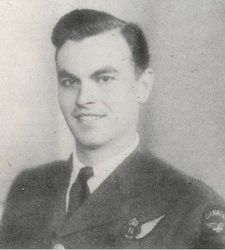
Art Towers, RCAF.
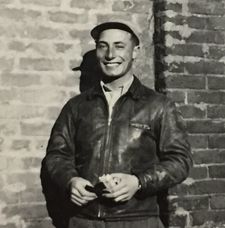
Tommy Tawse, RCAF.
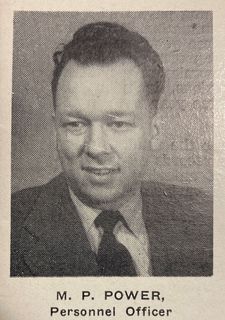
Parry Power.
- Art Towers – He started working at MPC in Brandon as an office boy in the late 1930s and by 1940 was at the MPC head office as merchandise accountant. He enlisted in 1941 and was a navigator in the RCAF. His aircraft was shot down while on mission to Berlin in 1944. Two crew members were killed. Towers was wounded and hospitalized in a German prisoner of war camp. When he recovered, he attempted to escape with another prisoner. He was one of thousands of prisoners liberated at the end of the war in 1945. He retired from Manitoba Hydro in the spring of 1975 as assistant manager of marketing.
- Tommy Tawse – He was assigned to RCAF 122 Squadron based in Patricia Bay B.C. to protect Canada’s West Coast. At the end of war, he returned to Brandon to work as a lineman for the MPC. He was one of two MPC employees killed September 13, 1957 in the explosion of the Brandon Steam Plant. He was 32.
- Parry Power – Following the end of the war in Europe in May 1945, Power, a resident of Virden, volunteered for the Pacific theatre. He was in the infantry. Before the war, Power was acting secretary for the MPC board. Power returned to MPC after the war in 1946. At the same time, he graduated the University of Manitoba with a Bachelor of Commerce degree. Three years later, he established the Personnel department, of which he was manager until 1966 when he created the position of Personnel Counsel. In that position, he created Hydro-X for retirees. He also officiated at First Scientist Church of Christ. He died January 28, 1988 at age 64. At the time, he was the utility’s longest serving employee.



